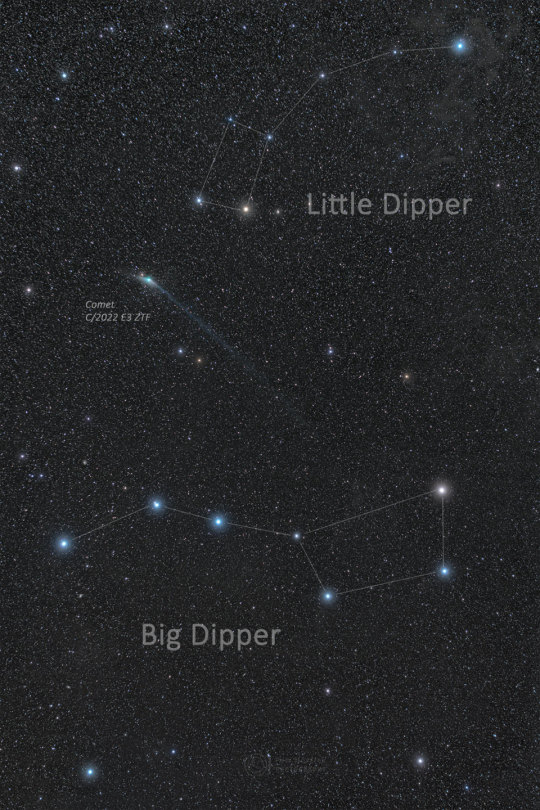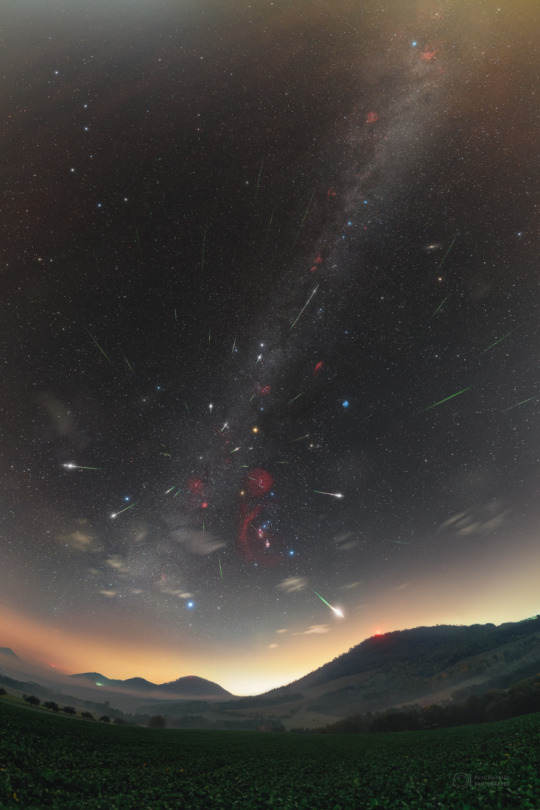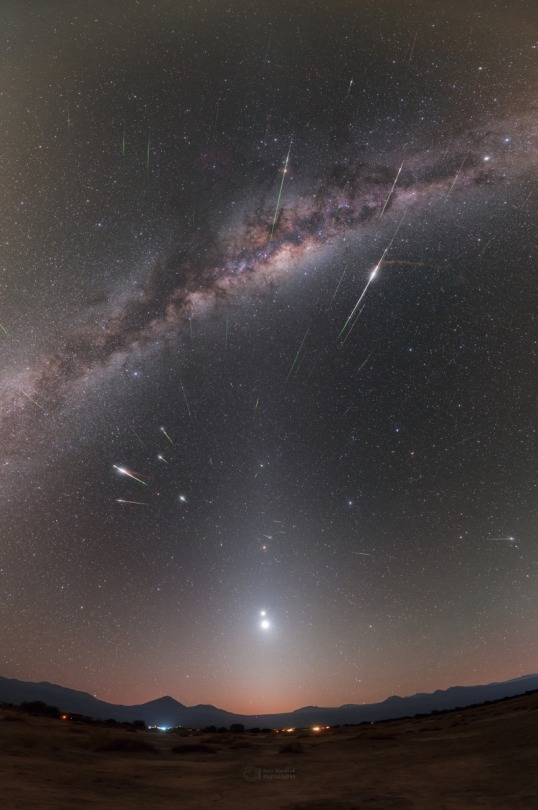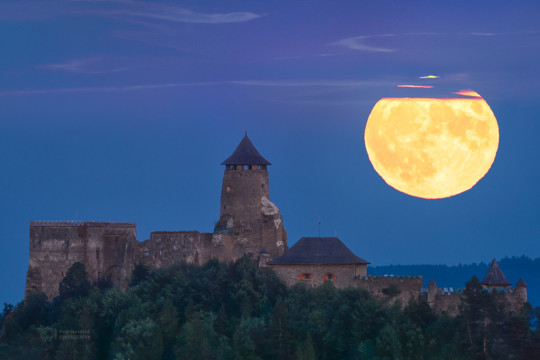#Petr Horalek
Text

A Full Plankton Moon: What glows in the night? This night featured a combination of usual and unusual glows. Perhaps the most usual glow was from the Moon, a potentially familiar object. The full Moon's nearly vertical descent results from the observer being near Earth's equator. As the Moon sets, air and aerosols in Earth's atmosphere preferentially scatter out blue light, making the Sun-reflecting satellite appear reddish when near the horizon. Perhaps the most unusual glow was from the bioluminescent plankton, likely less familiar objects. These microscopic creatures glow blue, it is thought, primarily to surprise and deter predators. In this case, the glow was caused primarily by plankton-containing waves crashing onto the beach. The image was taken on Soneva Fushi Island, Maldives just over one year ago.
Credit & Copyright: Petr Horálek / Institute of Physics in Opava
Explanation
[Robert Scott Horton]
* * * *
“Those roads were echoes and footsteps,
women, men, agonies, resurrections,
days and nights,
half dreams and dreams,
every obscure instant of yesterday
and of the world’s yesterdays,
the firm sword of the Dane and the moon of the Persian,
the deeds of the dead,
shared love, words,
Emerson and snow and so many things.
Now I can forget them. I reach my center,
my algebra and my key,
my mirror.
Soon I will know who I am.”
— Jorge Luis Borges, In praise of shadow
[alive on all channels]
#Jorge Luis Borges#In praise of shadow#alive on all channels#poetry#poem#Petr Horalek#Institute of Physics in Opava#Maldives#bioluminescent
46 notes
·
View notes
Text

Halley, Mars and Milky Way l Petr Horalek via NASA APOD
#space#nasa#apod#astrophotography#astronomy#milky way#comet#comet Halley#meteor shower#meteor#mars#solar system#stars#night#sky
3K notes
·
View notes
Text

From NASA (Astronomy Picture of the Day - March 11, 2024)
What glows in the night? This night featured a combination of usual and unusual glows. Perhaps the most usual glow was from the Moon, a potentially familiar object. The full Moon's nearly vertical descent results from the observer being near Earth's equator. As the Moon sets, air and aerosols in Earth's atmosphere preferentially scatter out blue light, making the Sun-reflecting satellite appear reddish when near the horizon. Perhaps the most unusual glow was from the bioluminescent plankton, likely less familiar objects. These microscopic creatures glow blue, it is thought, primarily to surprise and deter predators. In this case, the glow was caused primarily by plankton-containing waves crashing onto the beach. The image was taken on Soneva Fushi Island, Maldives just over one year ago.
Photographer credit: Petr Horalek
62 notes
·
View notes
Photo

Seven Years of Halley Dust
Credits: Petr Horalek, Institute of Physics in Opava
41 notes
·
View notes
Photo

2023 February 7
A Comet and Two Dippers
Image Credit & Copyright: Petr Horalek / Institute of Physics in Opava
Explanation: Can you still see the comet? Yes. Even as C/2022 E3 (ZTF) fades, there is still time to see it if you know where and when to look. Geometrically, Comet ZTF has passed its closest to both the Sun and the Earth and is now headed back to the outer Solar System. Its orbit around the Sun has it gliding across the northern sky all month, after passing near Polaris and both the Big and Little Dippers last month. Pictured, Comet ZTF was photographed between the two dippers in late January while sporting an ion tail that extended over 10 degrees. Now below naked-eye visibility, Comet ZTF can be found with binoculars or a small telescope and a good sky map. A good time to see the comet over the next week is after the Sun sets -- but before the Moon rises. The comet will move nearly in front of Mars in a few days
∞ Source: apod.nasa.gov/apod/ap230207.html
208 notes
·
View notes
Photo

Seven Years of Halley Dust Image Credit & Copyright: Petr Horalek / Institute of Physics in Opava Explanation: History's first known periodic comet Halley (1P/Halley) returns to the inner Solar System every 75 years or so. The famous comet made its last appearance to the naked-eye in 1986. But dusty debris from Comet Halley can be seen raining through planet Earth's skies twice a year during two annual meteor showers, the Eta Aquarids in May and the Orionids in October. Including meteors near the shower maximum on October 21, this composite view compiles Orionid meteors captured from years 2015 through 2022. About 47 bright meteors are registered in the panoramic night skyscape. Against a starry background extending along the Milky Way, the Orionid meteors all seem to radiate from a point just north of Betelgeuse in the familiar constellation of the Hunter. In the foreground are mountains in eastern Slovakia near the city of Presov. https://apod.nasa.gov/apod/ap221028.html #NASA #photography https://www.instagram.com/p/CkQXgcJuL5U/?igshid=NGJjMDIxMWI=
2 notes
·
View notes
Photo

Seven Years of Halley Dust - Petr Horalek
History's first known periodic comet Halley (1P/Halley) returns to the inner Solar System every 75 years or so. The famous comet made its last appearance to the naked-eye in 1986. But dusty debris from Comet Halley can be seen raining through planet Earth's skies twice a year during two annual meteor showers, the Eta Aquarids in May and the Orionids in October. Including meteors near the shower maximum on October 21, this composite view compiles Orionid meteors captured from years 2015 through 2022. About 47 bright meteors are registered in the panoramic night skyscape. Against a starry background extending along the Milky Way, the Orionid meteors all seem to radiate from a point just north of Betelgeuse in the familiar constellation of the Hunter. In the foreground are mountains in eastern Slovakia near the city of Presov.
2 notes
·
View notes
Text
Petr Horalek | Sushi Island, Maldives
This photo was taken by Petr Horalek on Sushi Island, Maldives, showing the full Moon’s nearly vertical descent.
The Sun-reflecting satellite appears redder as it gets closer to the horizon because blue light is preferentially scattered away by air and particles in Earth's… pic.twitter.com/1L94i8BG0J
— James Drake (@jamesjpdrake) March 11, 2024
View On WordPress
0 notes
Text

APOD: Halley Dust, Mars Dust, and Milky Way (5/12/23)
Grains of cosmic dust streaked through night skies in early May. Swept up as planet Earth plowed through the debris streams left behind by periodic Comet Halley, the annual meteor shower is known as the Eta Aquarids. This year, the Eta Aquarids peak was visually hampered by May's bright Full Moon, though. But early morning hours surrounding last May's shower of Halley dust were free of moonlight interference. In exposures recorded between April 28 and May 8 in 2022, this composited image shows nearly 90 Eta Aquarid meteors streaking from the shower's radiant in Aquarius over San Pedro de Atacama, Chile. The central Milky Way arcs above in the southern hemisphere's predawn skies. The faint band of light rising from the horizon is Zodiacal light, caused by dust scattering sunlight near our Solar System's ecliptic plane. Along the ecliptic and entrained in the Zodiacal glow are the bright planets Venus, Jupiter, Mars, and Saturn. Of course Mars itself has recently been found to be a likely source of the dust along the ecliptic responsible for creating Zodiacal light.
© Petr Horalek
0 notes
Text
A Comet and Two Dippers

Can you still see the comet? Yes. Even as C/2022 E3 (ZTF) fades, there is still time to see it if you know where and when to look. Geometrically, Comet ZTF has passed its closest to both the Sun and the Earth and is now headed back to the outer Solar System. Its orbit around the Sun has it gliding across the northern sky all month, after passing near Polaris and both the Big and Little Dippers last month. Pictured, Comet ZTF was photographed between the two dippers in late January while sporting an ion tail that extended over 10 degrees. Now below naked-eye visibility, Comet ZTF can be found with binoculars or a small telescope and a good sky map. A good time to see the comet over the next week is after the Sun sets -- but before the Moon rises. The comet will move nearly in front of Mars in a few days.
Image Credit & Copyright: Petr Horalek / Institute of Physics in Opava
0 notes
Photo

Lubovna Full Moon
Image Credit & Copyright: Petr Horalek / Institute of Physics in Opava
Explanation: On July 13 this well-planned telephoto view recorded a Full Moon rising over Lubovna Castle in eastern Slovakia. The photographer was about 3 kilometers from the castle walls and about 357,000 kilometers from this Full Moon near perigee, the closest point in its elliptical orbit. Known to some as supermoons, full moons near perigee are a little brighter and larger in planet Earth's sky when compared to full moons that occur near the average lunar distance of around 384,000 kilometers. Of course any Full Moon near the horizon can show the effects of refraction over a long sight-line through dense clear atmosphere. In this image, atmospheric refraction creates the slight green flash framed by thin clouds near the top, with a ragged red rim along the bottom edge of July's perigee Full Moon.
0 notes
Photo

Perseids from Perseus !
Image Credit & Copyright: Petr Horalek
#art#photography#perseids#perseus#petr horalek#meteors#constellation#universe#cosmos#cosmic#blast#comet#meteor shower#slovakia#kolonica observatory#cosmos wallpaper
46 notes
·
View notes
Text

a rare halo around the planet Jupiter above the Atacama desert in Chile captured by: Petr Horalek 4000x6000 full resolution
37 notes
·
View notes
Photo

Perseus and the Lost Meteors
Credits: Tomas Slovinsky, Slovakia, Petr Horalek, Czech Republic, Institute of Physics in Opava
32 notes
·
View notes
Photo

2023 May 12
Halley Dust, Mars Dust, and Milky Way
Image Credit & Copyright: Petr Horalek / Institute of Physics in Opava
Explanation: Grains of cosmic dust streaked through night skies in early May. Swept up as planet Earth plowed through the debris streams left behind by periodic Comet Halley, the annual meteor shower is known as the Eta Aquarids. This year, the Eta Aquarids peak was visually hampered by May's bright Full Moon, though. But early morning hours surrounding last May's shower of Halley dust were free of moonlight interference. In exposures recorded between April 28 and May 8 in 2022, this composited image shows nearly 90 Eta Aquarid meteors streaking from the shower's radiant in Aquarius over San Pedro de Atacama, Chile. The central Milky Way arcs above in the southern hemisphere's predawn skies. The faint band of light rising from the horizon is Zodiacal light, caused by dust scattering sunlight near our Solar System's ecliptic plane. Along the ecliptic and entrained in the Zodiacal glow are the bright planets Venus, Jupiter, Mars, and Saturn. Of course Mars itself has recently been found to be a likely source of the dust along the ecliptic responsible for creating Zodiacal light.
∞ Source: apod.nasa.gov/apod/ap230512.html
92 notes
·
View notes
